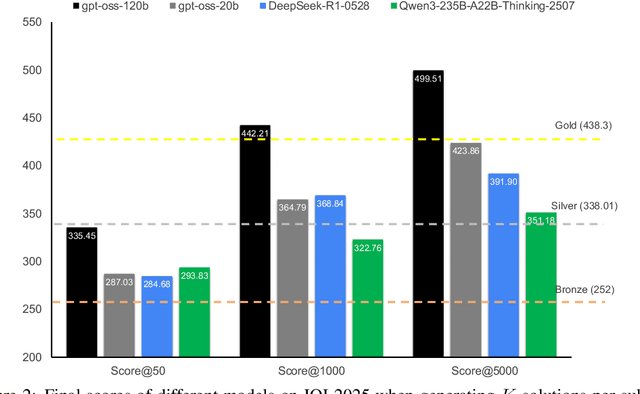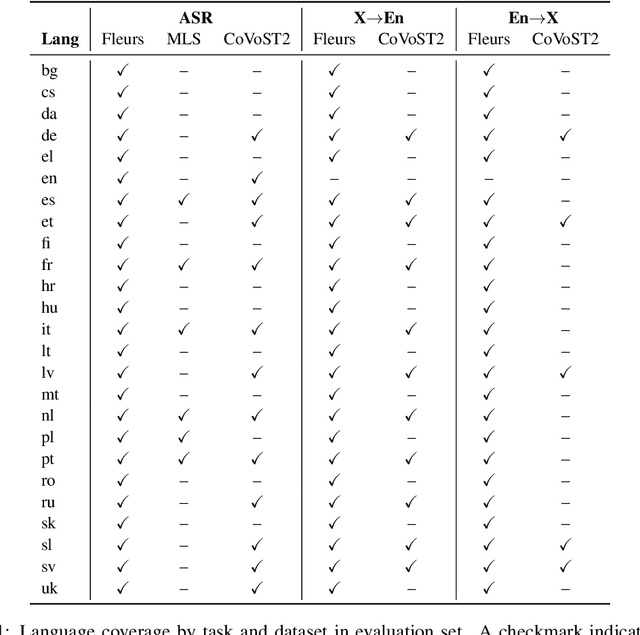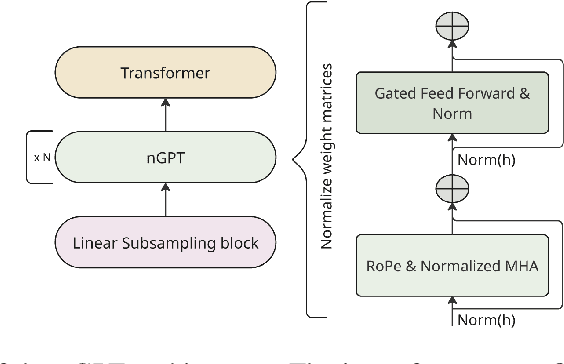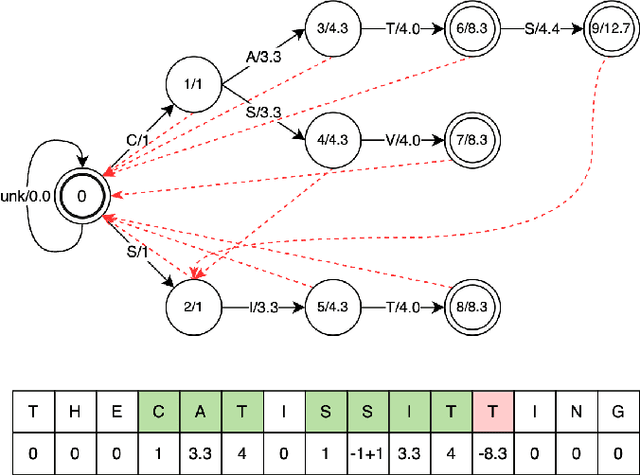Boris Ginsburg
NVIDIA Nemotron 3: Efficient and Open Intelligence
Dec 24, 2025Abstract:We introduce the Nemotron 3 family of models - Nano, Super, and Ultra. These models deliver strong agentic, reasoning, and conversational capabilities. The Nemotron 3 family uses a Mixture-of-Experts hybrid Mamba-Transformer architecture to provide best-in-class throughput and context lengths of up to 1M tokens. Super and Ultra models are trained with NVFP4 and incorporate LatentMoE, a novel approach that improves model quality. The two larger models also include MTP layers for faster text generation. All Nemotron 3 models are post-trained using multi-environment reinforcement learning enabling reasoning, multi-step tool use, and support granular reasoning budget control. Nano, the smallest model, outperforms comparable models in accuracy while remaining extremely cost-efficient for inference. Super is optimized for collaborative agents and high-volume workloads such as IT ticket automation. Ultra, the largest model, provides state-of-the-art accuracy and reasoning performance. Nano is released together with its technical report and this white paper, while Super and Ultra will follow in the coming months. We will openly release the model weights, pre- and post-training software, recipes, and all data for which we hold redistribution rights.
Nemotron 3 Nano: Open, Efficient Mixture-of-Experts Hybrid Mamba-Transformer Model for Agentic Reasoning
Dec 23, 2025Abstract:We present Nemotron 3 Nano 30B-A3B, a Mixture-of-Experts hybrid Mamba-Transformer language model. Nemotron 3 Nano was pretrained on 25 trillion text tokens, including more than 3 trillion new unique tokens over Nemotron 2, followed by supervised fine tuning and large-scale RL on diverse environments. Nemotron 3 Nano achieves better accuracy than our previous generation Nemotron 2 Nano while activating less than half of the parameters per forward pass. It achieves up to 3.3x higher inference throughput than similarly-sized open models like GPT-OSS-20B and Qwen3-30B-A3B-Thinking-2507, while also being more accurate on popular benchmarks. Nemotron 3 Nano demonstrates enhanced agentic, reasoning, and chat abilities and supports context lengths up to 1M tokens. We release both our pretrained Nemotron 3 Nano 30B-A3B Base and post-trained Nemotron 3 Nano 30B-A3B checkpoints on Hugging Face.
Scaling Test-Time Compute to Achieve IOI Gold Medal with Open-Weight Models
Oct 16, 2025



Abstract:Competitive programming has become a rigorous benchmark for evaluating the reasoning and problem-solving capabilities of large language models (LLMs). The International Olympiad in Informatics (IOI) stands out as one of the most prestigious annual competitions in competitive programming and has become a key benchmark for comparing human and AI-level programming ability. While several proprietary models have been claimed to achieve gold medal-level performance at the IOI, often with undisclosed methods, achieving comparable results with open-weight models remains a significant challenge. In this paper, we present \gencluster, a scalable and reproducible test-time compute framework that attains IOI gold-level performance using open-weight models. It combines large-scale generation, behavioral clustering, ranking, and a round-robin submission strategy to efficiently explore diverse solution spaces under limited validation budgets. Our experiments show that the performance of our proposed approach scales consistently with available compute, narrowing the gap between open and closed systems. Notably, we will show that GenCluster can achieve a gold medal at IOI 2025 for the first time with an open-weight model gpt-oss-120b, setting a new benchmark for transparent and reproducible evaluation of reasoning in LLMs.
Canary-1B-v2 & Parakeet-TDT-0.6B-v3: Efficient and High-Performance Models for Multilingual ASR and AST
Sep 17, 2025



Abstract:This report introduces Canary-1B-v2, a fast, robust multilingual model for Automatic Speech Recognition (ASR) and Speech-to-Text Translation (AST). Built with a FastConformer encoder and Transformer decoder, it supports 25 languages primarily European. The model was trained on 1.7M hours of total data samples, including Granary and NeMo ASR Set 3.0, with non-speech audio added to reduce hallucinations for ASR and AST. We describe its two-stage pre-training and fine-tuning process with dynamic data balancing, as well as experiments with an nGPT encoder. Results show nGPT scales well with massive data, while FastConformer excels after fine-tuning. For timestamps, Canary-1B-v2 uses the NeMo Forced Aligner (NFA) with an auxiliary CTC model, providing reliable segment-level timestamps for ASR and AST. Evaluations show Canary-1B-v2 outperforms Whisper-large-v3 on English ASR while being 10x faster, and delivers competitive multilingual ASR and AST performance against larger models like Seamless-M4T-v2-large and LLM-based systems. We also release Parakeet-TDT-0.6B-v3, a successor to v2, offering multilingual ASR across the same 25 languages with just 600M parameters.
NVIDIA Nemotron Nano 2: An Accurate and Efficient Hybrid Mamba-Transformer Reasoning Model
Aug 21, 2025



Abstract:We introduce Nemotron-Nano-9B-v2, a hybrid Mamba-Transformer language model designed to increase throughput for reasoning workloads while achieving state-of-the-art accuracy compared to similarly-sized models. Nemotron-Nano-9B-v2 builds on the Nemotron-H architecture, in which the majority of the self-attention layers in the common Transformer architecture are replaced with Mamba-2 layers, to achieve improved inference speed when generating the long thinking traces needed for reasoning. We create Nemotron-Nano-9B-v2 by first pre-training a 12-billion-parameter model (Nemotron-Nano-12B-v2-Base) on 20 trillion tokens using an FP8 training recipe. After aligning Nemotron-Nano-12B-v2-Base, we employ the Minitron strategy to compress and distill the model with the goal of enabling inference on up to 128k tokens on a single NVIDIA A10G GPU (22GiB of memory, bfloat16 precision). Compared to existing similarly-sized models (e.g., Qwen3-8B), we show that Nemotron-Nano-9B-v2 achieves on-par or better accuracy on reasoning benchmarks while achieving up to 6x higher inference throughput in reasoning settings like 8k input and 16k output tokens. We are releasing Nemotron-Nano-9B-v2, Nemotron-Nano12B-v2-Base, and Nemotron-Nano-9B-v2-Base checkpoints along with the majority of our pre- and post-training datasets on Hugging Face.
FlexCTC: GPU-powered CTC Beam Decoding With Advanced Contextual Abilities
Aug 13, 2025Abstract:While beam search improves speech recognition quality over greedy decoding, standard implementations are slow, often sequential, and CPU-bound. To fully leverage modern hardware capabilities, we present a novel open-source FlexCTC toolkit for fully GPU-based beam decoding, designed for Connectionist Temporal Classification (CTC) models. Developed entirely in Python and PyTorch, it offers a fast, user-friendly, and extensible alternative to traditional C++, CUDA, or WFST-based decoders. The toolkit features a high-performance, fully batched GPU implementation with eliminated CPU-GPU synchronization and minimized kernel launch overhead via CUDA Graphs. It also supports advanced contextualization techniques, including GPU-powered N-gram language model fusion and phrase-level boosting. These features enable accurate and efficient decoding, making them suitable for both research and production use.
TurboBias: Universal ASR Context-Biasing powered by GPU-accelerated Phrase-Boosting Tree
Aug 12, 2025



Abstract:Recognizing specific key phrases is an essential task for contextualized Automatic Speech Recognition (ASR). However, most existing context-biasing approaches have limitations associated with the necessity of additional model training, significantly slow down the decoding process, or constrain the choice of the ASR system type. This paper proposes a universal ASR context-biasing framework that supports all major types: CTC, Transducers, and Attention Encoder-Decoder models. The framework is based on a GPU-accelerated word boosting tree, which enables it to be used in shallow fusion mode for greedy and beam search decoding without noticeable speed degradation, even with a vast number of key phrases (up to 20K items). The obtained results showed high efficiency of the proposed method, surpassing the considered open-source context-biasing approaches in accuracy and decoding speed. Our context-biasing framework is open-sourced as a part of the NeMo toolkit.
SPGISpeech 2.0: Transcribed multi-speaker financial audio for speaker-tagged transcription
Aug 07, 2025



Abstract:We introduce SPGISpeech 2.0, a dataset suitable for speaker-tagged transcription in the financial domain. SPGISpeech 2.0 improves the diversity of applicable modeling tasks while maintaining the core characteristic of the original SPGISpeech dataset: audio snippets and their corresponding fully formatted text transcriptions, usable for end-to-end automatic speech recognition (ASR). SPGISpeech 2.0 consists of 3,780 additional hours of professionally transcribed earnings calls. Furthermore, the dataset contains call and speaker information for each audio snippet facilitating multi-talker ASR. We validate the utility of SPGISpeech 2.0 through improvements in speaker-tagged ASR performance of popular speech recognition models after fine-tuning on SPGISpeech 2.0. Released free for non-commercial use, we expect SPGISpeech 2.0 to foster advancements in speech recognition technologies and inspire a wide range of research applications.
DeSTA2.5-Audio: Toward General-Purpose Large Audio Language Model with Self-Generated Cross-Modal Alignment
Jul 03, 2025Abstract:We introduce DeSTA2.5-Audio, a general-purpose Large Audio Language Model (LALM) designed for robust auditory perception and instruction-following, without requiring task-specific audio instruction-tuning. Recent LALMs typically augment Large Language Models (LLMs) with auditory capabilities by training on large-scale, manually curated or LLM-synthesized audio-instruction datasets. However, these approaches have often suffered from the catastrophic forgetting of the LLM's original language abilities. To address this, we revisit the data construction pipeline and propose DeSTA, a self-generated cross-modal alignment strategy in which the backbone LLM generates its own training targets. This approach preserves the LLM's native language proficiency while establishing effective audio-text alignment, thereby enabling zero-shot generalization without task-specific tuning. Using DeSTA, we construct DeSTA-AQA5M, a large-scale, task-agnostic dataset containing 5 million training samples derived from 7,000 hours of audio spanning 50 diverse datasets, including speech, environmental sounds, and music. DeSTA2.5-Audio achieves state-of-the-art or competitive performance across a wide range of audio-language benchmarks, including Dynamic-SUPERB, MMAU, SAKURA, Speech-IFEval, and VoiceBench. Comprehensive comparative studies demonstrate that our self-generated strategy outperforms widely adopted data construction and training strategies in both auditory perception and instruction-following capabilities. Our findings underscore the importance of carefully designed data construction in LALM development and offer practical insights for building robust, general-purpose LALMs.
NGPU-LM: GPU-Accelerated N-Gram Language Model for Context-Biasing in Greedy ASR Decoding
May 28, 2025Abstract:Statistical n-gram language models are widely used for context-biasing tasks in Automatic Speech Recognition (ASR). However, existing implementations lack computational efficiency due to poor parallelization, making context-biasing less appealing for industrial use. This work rethinks data structures for statistical n-gram language models to enable fast and parallel operations for GPU-optimized inference. Our approach, named NGPU-LM, introduces customizable greedy decoding for all major ASR model types - including transducers, attention encoder-decoder models, and CTC - with less than 7% computational overhead. The proposed approach can eliminate more than 50% of the accuracy gap between greedy and beam search for out-of-domain scenarios while avoiding significant slowdown caused by beam search. The implementation of the proposed NGPU-LM is open-sourced.
 Add to Chrome
Add to Chrome Add to Firefox
Add to Firefox Add to Edge
Add to Edge